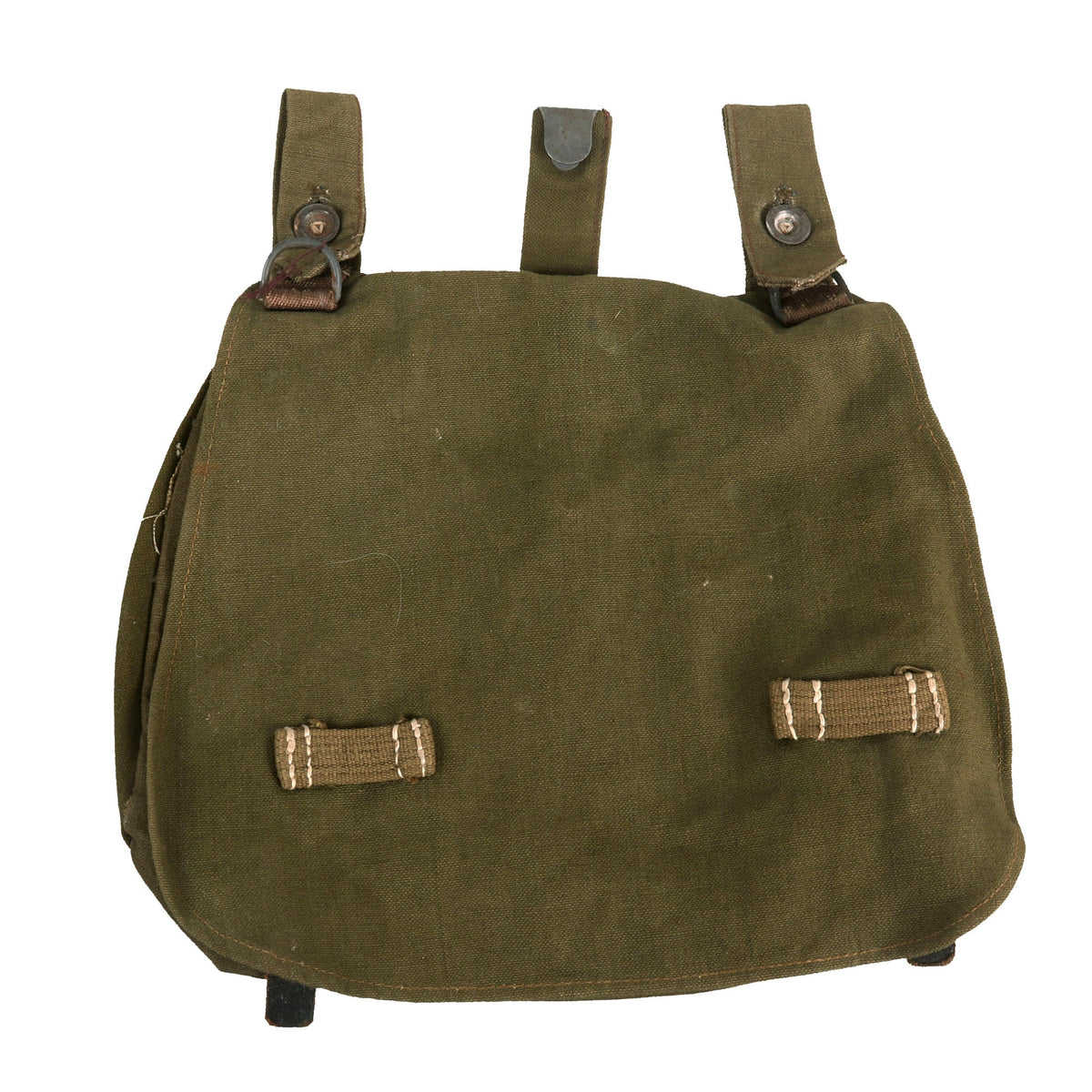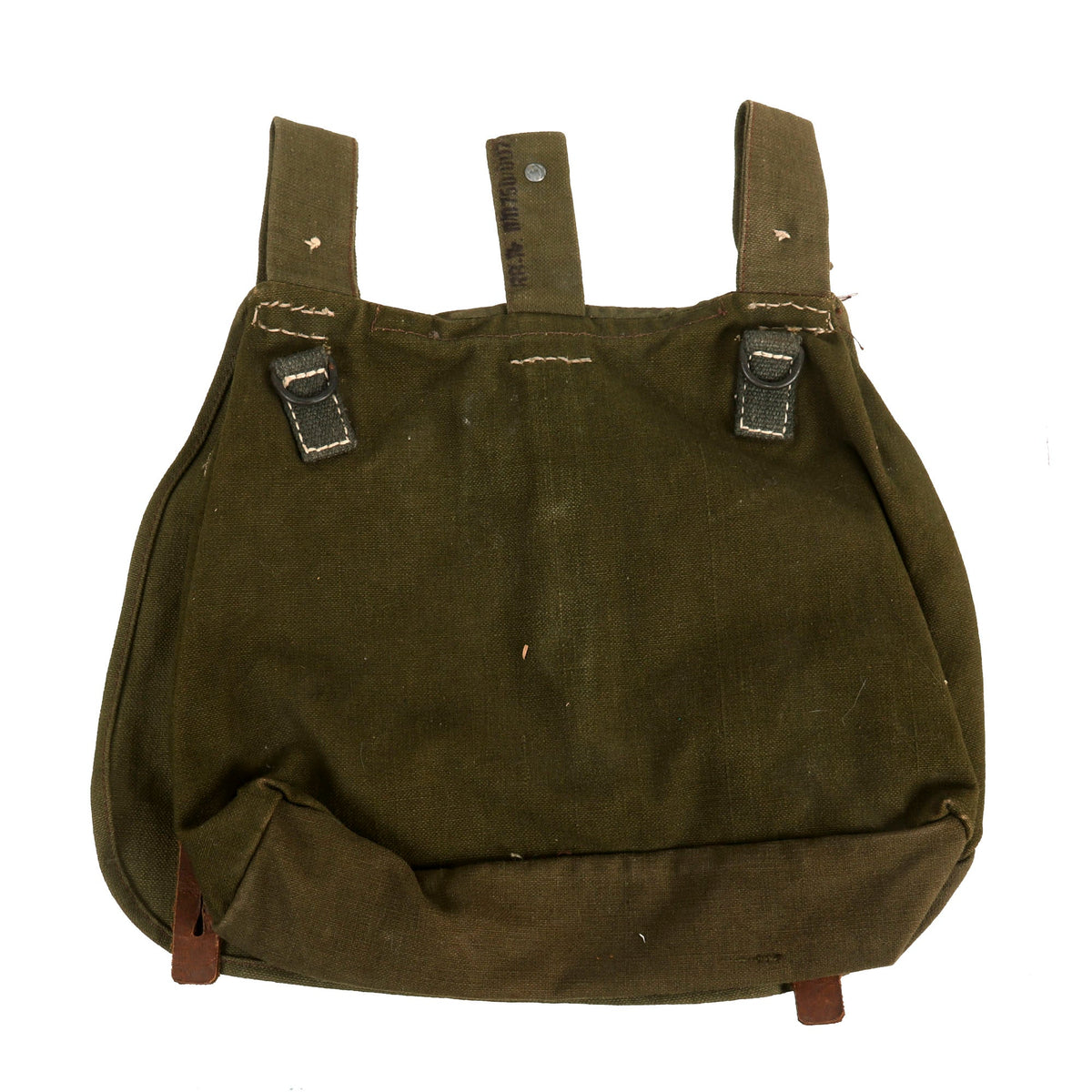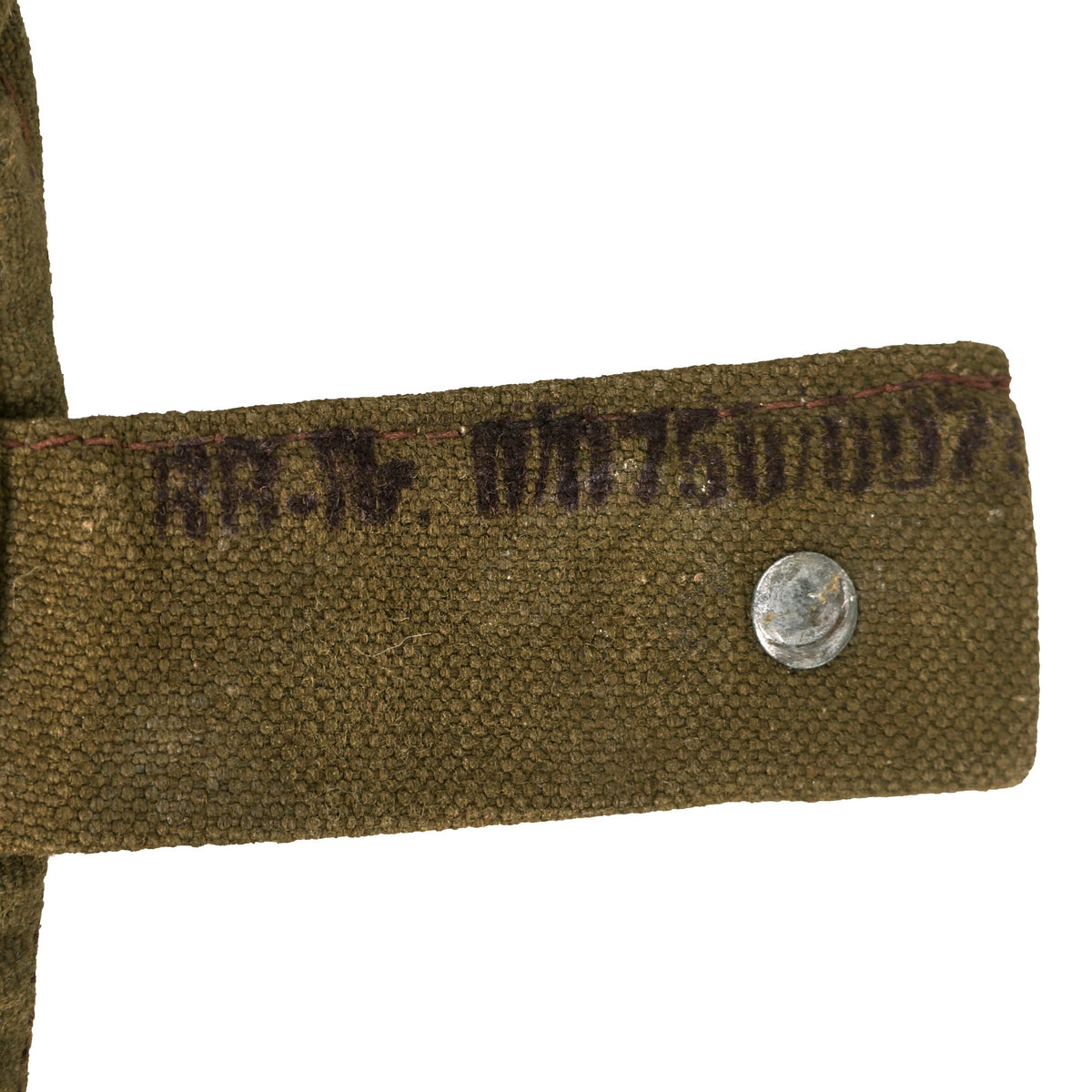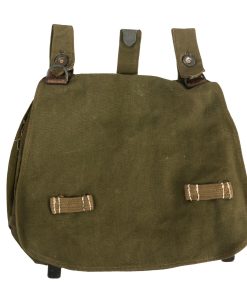Original German WWII Heer Army M31 Breadbag in Olive Green Canvas with RBNr. Marking Original Items
$ 250,00 $ 100,00
Original Item: Only One Available. This is a wonderful example of an M31 Haversack, also known as the “breadbag”. The bag itself does appear to be complete and has all original buttons, clips and leather securing tabs retained. The canvas body still has a lovely color to it and is similar in appearance to the tropical breadbags but has leather straps instead of the iconic webbing. These were brought out later in the war circa 1943-1944.
It is in very good condition, though the leather on it does show some deterioration and stretching, mainly on the closure straps. Many of the other straps and fittings are canvas, so this possibly could have been intended for the Tropical campaigns, or used parts left over from that style. It has a clear RB-Nr. 0/0750/0073 marking on the center strap with the hook.
A lovely example presented with some great original canvas. Comes more than ready for further research and display.
Several items of field gear were carried over from the First World War by the German military. One of the most well-known is the breadbag. This was a small bag which fastened to the belt and was used as a general purpose carry all bag for the most basic needs of a soldier. The same basic design was used for nearly 100 years by the German military, police and political organizations.
During WWII, the standard pattern bag was known as the “M31”. This featured minor changes from its WWI predecessor. The SA, HJ and a plethora of political and government organizations also had their own models but those will not be dealt with here. Most varied only in color and the number of loops on the flap from the standard M31.
Breadbags came in a variety of colors and fabrics. Generally, early and pre-War bags are made from cotton canvas which tends toward a gray or fieldgray color. 1940-42 dated bags are often more of a khaki-olive. At the same time, cotton shortages led to the introduction of a coarser linen or hemp canvas. This fabric is usually olive green, though shades of khaki and brown exist.
In 1940, an all-cloth bag was issued for use in hot climates. The bag was the same as the standard M31 except that the leather straps and tabs were replaced with cotton webbing pieces.
Late in the War, the M44 Breadbag was introduced. It was simplified for faster production and a small pocket was added to hold the rifle cleaning kit. Finally, a Volksturm model was made in 1944-45.
Reichsbetriebsnummer or RB number (also represented as RB Nr or Rbnr). Before the war, the Germans set up a system for registering and recording the factory information, the Reichsbetriebskartei. This was to help enable machine tabulation of facts and figures. It was from this that the Reichsbetriebsnummer came into being. The Reichsministerium für Rüstung und Kriegsproduktion (Ministry for Armaments and War Production) files survive today in the Bundesarchiv, however, these are only fragmentary. There is a holding file from the working group created by the Office of Machine Reporting in the Armament Office of the Reich Ministry for Armaments and War Production – their main focus was the operations of the industry group for which an economic interest was Armour production. This index provides information on the most important data of the companies covered by it, production profile, operating area, number of employees and the responsible operator.
As a prerequisite for the intended use of the punch-card method in the armaments industry, it was this system which gave rise to the Rbnr. The operating numbers were assigned by the competent local district offices of Machine reporting. (Bezirksstellen des Maschinellen Berichtswesens.) The index is in the form of index cards that are accessible numerically (approximately 14 meters of index cards!). Access to this register is only possible through the naming of this company, stating the place of production. The Reichsministerium für Rüstung und Kriegsproduktion files have multiple entries on the introduction of the factory and also the lot no.
The Rbnr code was used from 1943 onwards and replaced the makers name and address (or company logo) on government contract uniforms, caps and field equipment and knives. It is either rubber ink stamped on cloth or die stamped onto leather & metal items. It has been written countless times that this numeric code system was introduced as a security measure to help mask production locations. This was not the case but it was perhaps, a helpful by- product of the system. It is not unknown to find the Rbnr together with the maker’s info. Had it been a security measure, clearly this practise would have been banned.
So what was the Rbnr? It was a nine digit number and was normally represented thus: RB Nr: 0/000/0000.
The first prefix number could range from 0 through to 9. This number determined the membership of the various groups in the realm of Trade and Industry (Reichsgruppenleitzahl)
• 0 Industry
• 1 Crafts
• 2 Commercial wholesale trading companies
• 3 Banking
• 4 Insurance Companies
• 5 Energy (Electrical companies and such)
• 6 Tourism (Including Hotels, Wine and Mineral Water companies)
• 7 Traffic
• 8 Food Industry
• 9 Not otherwise mentioned groups
Fast Shipping with Professional Packaging
Thanks to our longstanding association with UPS FedEx DHL, and other major international carriers, we are able to provide a range of shipping options. Our warehouse staff is expertly trained and will wrap your products according to our exact and precise specifications. Prior to shipping, your goods will be thoroughly examined and securely secured. We ship to thousands clients each day across multiple countries. This shows how we're dedicated to be the largest retailer on the internet. Warehouses and distribution centres can be located throughout Europe as well as the USA.
Note: Orders with more than one item will be assigned a processing date depending on the item.
Before shipping before shipping, we'll conduct a thorough inspection of the items you have ordered. Today, the majority of orders will be delivered within 48 hours. The delivery time will be between 3-7 days.
Returns
The stock is dynamic and we cannot completely manage it because multiple stakeholders are involved, including our factory and warehouse. So the actual stock may alter at any time. It's possible that you may not receive your order once the order has been made.
Our policy is valid for a period of 30 days. If you don't receive the product within 30 days, we are not able to issue a refund or an exchange.
You can only return an item if it is unused and in the same state as the day you received it. You must have the item in its original packaging.
Related products
Uncategorized
Uncategorized
Uncategorized
Uncategorized
Uncategorized
Uncategorized
Uncategorized
Uncategorized
Uncategorized
Armored Burgonet Helmet & Polearm from Scottish Castle Leith Hall Circa 1700 Original Items
Uncategorized
Uncategorized
Uncategorized
Uncategorized
Uncategorized
Uncategorized
Band of Brothers ORIGINAL GERMAN WWII Le. F.H. 18 10.5cm ARTILLERY PIECE Original Items
Uncategorized
Uncategorized











































































